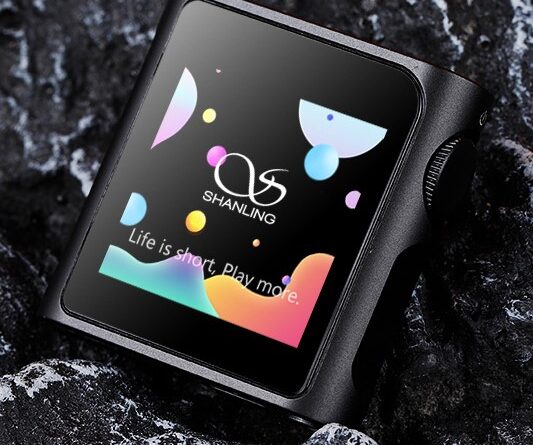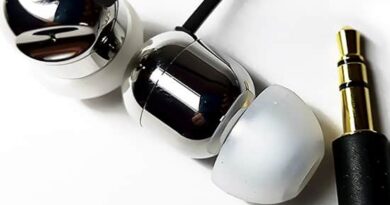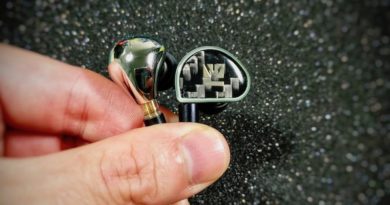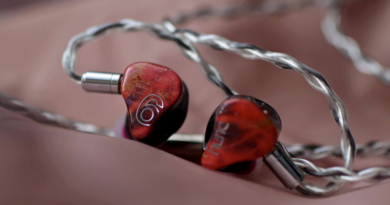Shanling M0 Pro Review – Mini Wonder
Not my first time with a Shanling product in my hands, yet this is no doubt the most eye-captivating one at the very least.
An M0 Pro has been sent to me for review by the manufacturer. You can find specs and full official description here. It currently retails for €155 including shipping from China and Italian VAT. Here’s my report.
In this Article
The Shanling M0 Pro was provided by Shanling for my review – and I thank them for that. You find more information on the product page.
At-a-glance Card
| PROs | CONs |
| Countleess nice features in a smartwatch-size thingie | Uninspiring single ended output quality |
| Good balanced output power | Balanced output requires separately sold adapter |
| Very good in/out BT connectivity | Balanced adapter only available with 4.4 port |
| Convenient in/out USB connectivity | Android companion app requires update (due soon) |
| Good touchscreen gestures implementation | |
| Very accurate design and build | |
| Android companion app for playback remote control | |
| Above decent battery life | |
| Shanling long term sw support realiability |
Features and description
Externals
The M0 Pro is amazingly small an featherweight : a bit less than 44 x 45 x 14mm and just 37g. Fits an Italian espresso coffe cup. For reference, an Apple Watch is minorly thinner and lighter…
The screen is 1.54″ (a bit less than 4cm diagonal) and offers a 240×240 pixel map. Definition is quite nice, and brightness (which can be sw-controlled) is OK for sunlight visibility.
Globally taken, M0 Pro exhudes design and build quality. The aluminum chassis is extremely well conceived in terms of ergonomics and haptics, so is the screen on its front face, which is even slightly curved at its edges to better connect with the housing.
Managing the GUI via that tiny screen may seem discouraging before trying, but it oppositely proves incredibly efficient thanks, I guess, to good hardware and some quite smart tap and swipe implementation choices (more on this later). Be as it may, using M0 Pro’s touch screen is easy and straighforward.
On the upper right side there’s the sole physical control being the general on-off / screen on-off / volume up-down button.
On the bottom panel there’s a slot for an SDC card (up to 2TB), a USB-C port and the 3.5mm phone out port.
Accessories
It’s not an “accessory”, but the carton packaging M0 Pro comes in is amongst the better designed, more captivating and nicer looking I ever met – at any price by the way. At Shanling they evidently care about consistent communcation and they – correctly – properly invest in the right complements to their main product to reinforce the positive user’s impression about the care they put in their products.
M0 Pro comes with a good quality factory-preinstalled screen protection film. A spare one is supplied too, it can be found inside the flat box containing product literature.
Part of the package is also a good quality USB-A to USB-C cable .
My sample unit was also supplied with a leather “jacket” – which is normally sold separately and in facts came in a standalone package. A very nice add-on, both for quality and even more for looks.
One thing worth noting is the jacket “embraces” the devices, and ends up “overlapping” the front screen by like 2 / 3mm on both left and right sides, and it’s like 1mm+ thick. I presume there’s little to do with such sizes / measures as long as one wants to keep the same raw material and manufacturing quality, however I feel it’s worth noting that the jacket prevents both horizontal thumb-swipe gestures to swing all the way from/to the very screen border(s). Tapping really close to screen borders is also nigh impossible – this, even to people with relatively lean fingers like myself.
Regarding horizontal swipe “span” – so to call it – Shanling support pointed my attention on the fact that on-screen swipes on M0 Pro do indeed work best (as in: more precise and responsive) when initiated from the center of the screen, not from its sides. And that’s true (I checked)! So once taken such habit, the jacket’s presence ceases to represent a hurdle for effective horizontal thumb swipes.
It stays however extremely hard (too hard, really) to tap very close to screen borders, which means that those “…” icons on the far right side of Album or Track lines on the GUI are de facto inaccessible when the jacket is on. A venial sin in my effective use case, yet still worth noting.
Lastly: considering how small and lightweight the device is, I find it a bit odd that no shirt-clip, nor wrist-strap addon/option is available. Not too difficult to find adaptable third party ones. however – also considering how nice the rest of the package is – I reckon the average M0 Pro user may reasonably expect “something” in that direction to be included within the box. I shared my thought with Shanling and they told me they are working on this.
Internals
The M0 Pro is based on an Ingenic X1000 SoC (System on a Chip). It’s an ultra low power microprocessor – take it as the mini-mini-brother of the CPU inside your smartphone. Spec sheet here.
The X1000 takes care of everything the device does (display, USB I/O, BT 5.0 I/O etc etc) bar the sole sound part, which is delegated to a pair of ESS ES9219C DAC/AMP chips (data sheet here), working in team.
The ES9219C is 32bit quad-dac audio SOC, one of those chips which are commonly used inside budget and/or small size audio devices where there is little space (economical and physical alike) to include separate components and tunings.
ES9219C processes PCM data up to 32bit / 384KHz and DSD native data up to DSD 128. Talking about DSD, accepted formats include DSF, DFF and even ISO.
The ES9219C sports brilliant power features considering its minuscle power requirements : 1,7V on 32 ohm corresponding to circa 90mW, and low output impedance (0.4 ohm). By integrating 2 of them in a Balanced scheme the M0 Pro can deliver up to 235mW @32ohm with a still interestingly low output impedance (0.8 ohm) when a balanced ended cabled driver is connected.
The dual chip option is also obviously the one to go in terms of sound quality: DR and SNR get better by 2dB, and most of all channel separation improves from 70 to 109dB.
The ESS SOC includes 4 standard and more programmable FIR filters, and M0 Pro offers a choice of 2 : a linear phase fast rolloff and an apodizing fast rollof – sadly no slow rolloff option available. (If you are unsure about FIR filters, you can read my piece here).
The M0 Pro includes a 640mAh battery which offers is up to 14h play time on single ended and 10h on balanced ended – which are plate figures as always. My direct experience talks more about 7-8h play time on Balanced which is still a good figure for such a tiny and small device. M0 Pro also offers weeks of sleep time thanks to negligible absorbtion when the device falls into deepsleep mode.
Software
M0 Pro has a surprisingly complete operating system and audio playback application.
Apart from the necessarily “miniaturised GUI”, resolving into totally excusable concessions for example in terms of labels readability and such, the vast majority of the key features regularly available on much higher end DAP are available to the user, and even some ones that are not so common to find on any DAP, too.
I’ll mention here those I consider most interesting / handy. Take into account that what follows is not a complete list (!).
A 10-band graphic equaliser is present, featuring separate attenuation control, 12 pre-defined profiles and 3 “blank” ones. All profiles (13+3) are customisable and get saved once modified. Their names cannot be changed, that’s the sole real limitation.
There is a Low / High Gain option switch, and a Gapless playback switch too.
A switch to select one’s preferred FIR filter is also available.
It’s possible to define a Max Volume. This is handy if you know you’ll be using very sensitive IEMs and don’t want to run the risk to pierce your eardrums by mistake. On a similar line, it’s possible to set the Default Volume, i.e. the volume which is set when you turn the M0 Pro on, irregardless to what value was it set at when you turned it off.
On DAPs I normally use folder-level navigation onto the library. For those who are rather keen on using tag-level navingation, M0 Pro gives you the possibility to choose amongst Artist or Album Artist sorting – which is crucial for my experience.
You can customise after how long the screen turns off, and wether the Volume wheel will stay active or not while the screen is off. You can also set wether the device is to just go to “sleep” after 1 min of inactivity, or it has fully shust down after 1 or more inactivity minutes.
A switch defines if the 3.5mm connector delivers Headphone output, or Line output. In the latter case, the volume control is set to Max Fixed.
Another switch defines how the USB port is supposed to behave: just allow for battery charging, provide USB digital output (e.g. to connect a dongle or a DAC/AMP), or receive USB digital input (e.g. to connect the M0 Pro to a PC or a phone as an external DAC/AMP.
When set for digital USB out, with another control you also switch between fixed and variable (digital) volume – the latter being handy of course when the downstream DAC/AMP does not have its own independent volume control, the former being best (higher output quality) in the opposite case.
An android (only) companion app is available which allows for remote-controlling playback on M0 Pro from a smartphone. It’s called Eddict Player and can be downloaded by the public Google Play store. It’s in fact a full-blown music player, offering a feature set very similar to that of HiBy’s HiByMusic, if you know that.
The remote controlling mechanism also works very similarly to HiBy’s case : you need to enable a SincLink option under M0 Pro’s Settings menu, in addition to BT communication – once that’s enabled, the Eddict Player app will be able to “find” the M0 Pro as a pairable device, and take control of it. Once the M0 Pro is under control, you can select music, and manage basic playback (play, stop, pause). Nothing else, sadly – so no remote access to advanced features like EQ, filter selection etc is available.
Last but likely not least I must note how commendable is on-screen swipe gestures’ implementation on M0 Pro. Given how tiny the screen is, a very accurate tuning must have been run on this aspect to find the right compromise in favour of the user’s comfort.
Tap is of course the way to “click” and “drill down” the various options, and right-swipe is the way to “back-track up” from any tree branch. The latter potentially being a bit tedious (it takes 5 right-swipes to get from Track-being-played all the way up to the main menu), long-tapping on any screen brings you straight to Home screen (Yeah I know, that’s unexpected. What can I say? RTFM…)
Up/down swipe is of course the way to scroll through lists (folders contents, settings options etc). That’s probably where some “hand” has to be taken at first to “calibrate” how the “short swipe” stroke you want to command a quick scroll: making it “too strong” makes the scroll “too wide”. Nothing that can’t be managed in more than 1 day of direct experience.
Input
The main way to feed music to the M0 Pro is of course by means of an SD Card. The most recent ones are accepted, up to 2TB capacity.
Two altenative input routes are also available: Bluetooth and USB.
When used as BT 5.0 receiver M0 Pro supports LDAC, SBC and AAC codecs (no APTX available in receiver mode). LDAC connectivity in particular is for my experience very stable and works with no glitch with my Samsung phone.
Considering how small the M0 Pro is, it can in pratice be used as sort of “addon BT receiver” for otherwise wired-only headphones/earphones.
The less-than-desireable thing about BT-receive mode is that it is essentially modeless. The sole thing you can do when a source is streaming music to M0 Pro via BT is adjusting volume. The EQ, for example, is not available. Nor any other GUI controls.
The M0 Pro also can be used as a USB DAC/AMP. I.e., you can connect it to a PC, Mac or Linux host, to an Android phone via an OTG cable or to an iPhone via the Apple Camera adapter. When connected, those sources will “see” the M0 Pro as an external DAC/AMP.
Similarly to the BT situation, no sound control except volume is available while USB-receiving. You can however decide via a switch if you want or not the M0 Pro to get recharging power from the USB connection while playing.
An odd difference between BT and USB input cases is the following: while the M0 Pro is in BT-input mode, swiping on the screen makes a pop-up appear asking the user if they want to stop BT transmission – so one can just tap NO in case of mistake; no pop-up happens when swiping while in USB-input mode – so an unwanted swipe produces an automatic sudden break-up of the stream.
M0 Pro is a pure DAP, there is no way to feed it with analog input. You cannot use it as a mere “amp”.
Output
M0 Pro’s main output is – of course – the analog 3.5 port on its bottom panel.
By default, that port provides single-ended Headphone output signal.
A GUI control allows for switching into Line Out mode. In that case the output volume is set to Max-Fixed. This mode is what you want to set the M0 Pro at when using it as a pure DAC, or DAC+Preamp, connecting it to a downstream amplifier.
Last but certainly not least, M0 Pro’s 3.5 port actually has a special internal structure allowing for a special 3.5 pentaconn-male to 4.4 pentaconn-female short adapter cable, purchaseable separately. Via such adapter you can plug any 4.4-balanced wired driver (or, by means of a further adapter, any 2.5-balanced driver, too).
Considering M0 Pro’s super-tiny size I guess this was the sole available way to provide both single ended and balanced ended connectivity, so that’s understandable. Of course having to (separately) purchase an adapter is less than ideal but there’s little to complain given what just said. Sole oddity: Shanling only offers the 4.4-female version of the adapter, no 2.5-female version available – at least for now.
In addition to its analog output, M0 Pro also allows for BT and USB interfaces to be used as digital outputs.
It’s possible to connect BT 5.0 compliant devices (TWS drivers, or BT streamers) to M0 Pro. In this case LDAC, SBC, AAC and APTx codecs are available.
And finally, it’s possible to connect M0 Pro to the USB input port of a standalone DAC, DAC-AMP, or to a dongle, defacto using it as a tiny transport.
Of course in the built-in battery being calibrated for the needs of the M0 Pro itself will do what it can when a high power requiring dongle is connected – so appropriate countermeasures with a side-battery and a Y-USB cable better be taken in that case.
Sound quality and power
Very much in the line of most devices offering both single ended and balanced output, M0 Pro shows a dramatic difference between the two cases in terms of sound quality. Long story short: this is yet another case where balanced output is the sole one you really want.
From its balanced output M0 Pro sounds way above decent. Of course it won’t replace a mid-tier DAP, let alone a high end one, however the sound quality compromise vis-a-vis this little boy’s minuscle size and convenience is waaaay acceptable.
M0 Pro has a quite relaxed sound presentation, nicely extended bass, and nice treble. No signs of shoutyness in the highmids, indeed the opposite, if something – a tad relaxed and tamed, overall “soft”.
Aa for output power capabilities – from the Balanced ended port – the situation in terms of voltage swing is very good, while obviously limited in terms of current delivery.
M0 Pro’s power vs the “usual” 16 to 30 ohm impedance, 105++ db/mW sensitivity IEMs is way enough not to bother about this piece of info. For the more curious, M0 Pro delivers 236mW on 32 ohm, which is “good”.
On high impedance loads – like an HD600 for example – M0 Pro deliver almost 3V, enough to make those cans sing properly when the original digital material is not particularly tamed – which is the most common case. There’s only little room to compensate for low tracks volume (e.g. vinyl digitisations, DSD conversion compensations, pre-attenuations due to important EQ compensations).
On the opposite end M0 Pro – like most of its similar priced peers, and most DAPs in general indeed – won’t be able to properly feed < 16 ohm, < 100 dB/mW drivers. Although I didn’t (as always) bother measuring it, it’s quite clear that the system quickly runs out of current under a certain threshold load condition. The usual workbench E5000 sound tamed, dark, unresolving. Simply put: forget M0 Pro for such type of “job”.
Considerations & conclusions
I am more than impressed by M0 Pro. It’s a unique, very well made DAP featuring minuscle size and weight, paired with a bold feature set and way more than decent sonic performaces at an affordable price.
When looking at its totally reasonable price point, and the countless features it offers, I’d get as far ahead as stating that whoever is not excessively concerned with “top-audiophile-level” sound quality may easily be find M0 Pro the one DAP that makes sense owning.
Weighing output capabilities (quality and power) vs price M0 Pro comes out as a remarkable offering in the DAP market. To my experience it’s quite tough to do better with a € 150 tax included nowadays: also considering Sony A55 is sadly discontinued, DAPs delivering significantly better sound and features cost almost 2, better 3 times more.
Different is the case if we take the DAP format out of the equation, and we consider sheer sound quality and power vs a 150€ budget – in such case E1DA dongles still run circles around any similar or somewhat higher priced competitor – but that’s another story of course, that’s why I mention it here below-the-line, for completeness.
All in all, M0 Pro gets my solid recommendation as a difficult-to-beat allrounder DAP for non-extreme audiophiles. And even those with a more audiophile tooth – so to call them – may consider M0 Pro when looking for a super-portable if a tad relaxed-sonic-quality companion for outdoors or such.
Our generic standard disclaimer.







